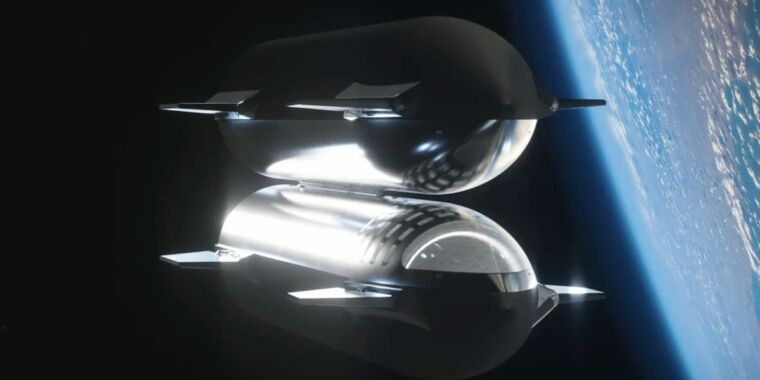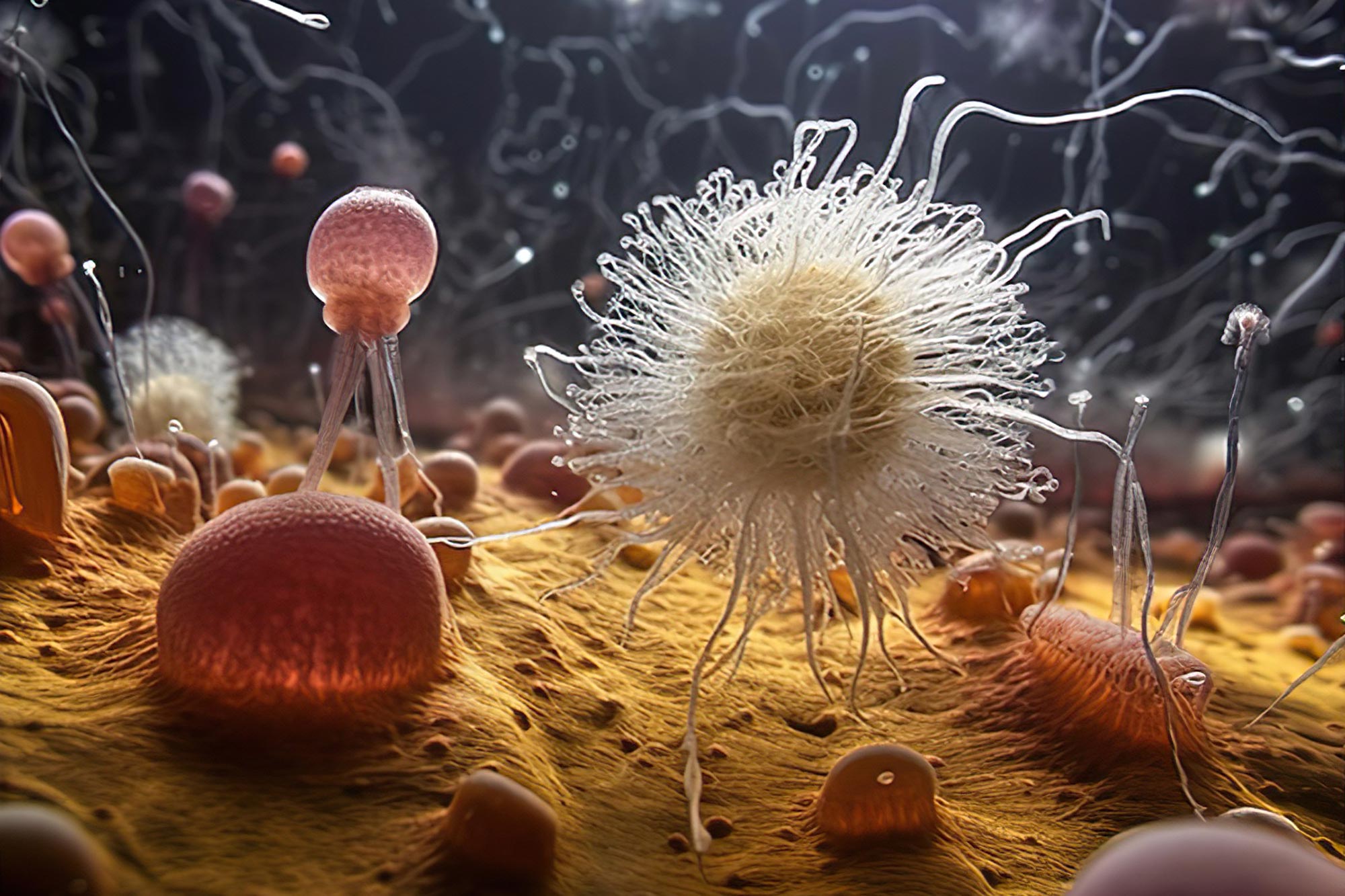por
A imaginação do artista de um grupo de eucariontes primitivos da “Protosterol Biota” vivendo em um tapete bacteriano no fundo do oceano. Com base em fósseis moleculares, os organismos Protosterol Biota viveram nos oceanos de cerca de 1,6 a 1,0 bilhão de anos atrás e são nossos ancestrais mais antigos conhecidos. Crédito: Organizado em MidJourney por TA 2023
Uma equipe de pesquisa multinacional encontrou protoesteróides antigos nas rochas, indicando que a vida complexa existia há 1,6 bilhão de anos. Essas moléculas fornecem uma nova visão sobre a evolução da vida complexa e reconciliam as discrepâncias entre os registros fósseis tradicionais e lipídicos.
Acontece que o registro recém-descoberto dos chamados protoesteróides foi surpreendentemente abundante durante a Idade Média da Terra. Moléculas primordiais foram produzidas em um estágio inicial na complexidade dos eucariotos – estendendo o registro atual de esteróis fósseis além de 800 e até 1.600 milhões de anos atrás. Eukaryotes é um termo dado ao reino da vida, incluindo todos os animais, plantas e algas e é separado das bactérias por ter uma estrutura celular complexa que inclui um núcleo, bem como um mecanismo molecular mais complexo.
“O destaque desta descoberta não é simplesmente uma extensão do registro molecular atual de eucariotos”, diz Christian Hollmann, um dos co-cientistas do Centro de Pesquisa Alemão para Geociências (GFZ) em Potsdam. “Dado que o último ancestral comum de todos os eucariotos modernos, incluindo nós humanos, provavelmente foi capaz de produzir esteróis modernos ‘regulares’, é provável que os eucariotos responsáveis por essas assinaturas raras pertençam ao tronco da árvore filogenética”.

Benjamin Nettersheim, um dos principais autores do estudo, examina mapas elementares e moleculares de super-resolução de amostras de rochas de 1,64 bilhão de anos analisadas no Laboratório de Imagem Molecular Geobiológica do MARUM. Crédito: MARUM – Centro de Ecologia Marinha, Universidade de Bremen; em Descamps
Este “toco” representa a linhagem ancestral comum que foi a precursora de todos os ramos vivos dos eucariotos. Seus representantes estão extintos há muito tempo, mas detalhes de sua natureza podem lançar mais luz sobre as circunstâncias que cercam a evolução da vida complexa. Embora sejam necessárias mais pesquisas para avaliar qual porcentagem de protoesteróides pode ter uma fonte bacteriana rara, a descoberta dessas novas moléculas não apenas reconcilia o registro geológico de fósseis tradicionais com o das moléculas de gordura fóssil, mas também oferece um vislumbre raro e sem precedentes do mundo. .perdido da velha vida. O desaparecimento competitivo dos eucariotos do grupo tronco, marcado pelo primeiro aparecimento de estromais fósseis modernos há cerca de 800 milhões de anos, pode refletir um dos eventos mais duradouros na evolução da vida cada vez mais complexa.
acrescenta Benjamin Nittersheim de Marom, Universidade de Bremen, que foi o primeiro autor do estudo com Jochen Brooks de[{” attribute=””>Australian National University (ANU) – “due to potentially adverse health effects of elevated cholesterol levels in humans, cholesterol doesn’t have the best reputation from a medical perspective. However, these lipid molecules are integral parts of eukaryotic cell membranes where they aid in a variety of physiological functions. By searching for fossilized steroids in ancient rocks, we can trace the evolution of increasingly complex life.”

Dr. Nettersheim inserts a thin section and rock slices of 1.64 billion-years old rocks into the 7T solariX XR FT-ICR-MS equipped with a MALDI source at the Geobiomolecular Imaging Laboratory at MARUM. As part of ongoing research into mid-Proterozoic biomarker signatures at MARUM, GFZ and the Australian National University, Dr. Nettersheim aims to zoom into the cradle of eukaryotic life in unprecedented resolution. Credit: MARUM – Center for Marine Environmental Sciences, University of Bremen; V. Diekamp
Nobel laureate Konrad Bloch had already speculated about such a biomarker in an essay almost 30 years ago. Bloch suggested that short-lived intermediates in the modern biosynthesis of steroids may not always have been intermediates. He believed that lipid biosynthesis evolved in parallel with changing environmental conditions throughout Earth history. In contrast to Bloch, who did not believe that these ancient intermediates could ever be found, Nettersheim started searching for protosteroids in ancient rocks that were deposited at a time when those intermediates could actually have been the final product.
But how to find such molecules in ancient rocks? “We employed a combination of techniques to first convert various modern steroids to their fossilized equivalent; otherwise, we wouldn’t have even known what to look for,” says Jochen Brocks. Scientists had overlooked these molecules for decades because they do not conform to typical molecular search images. “Once we knew our target, we discovered that dozens of other rocks, taken from billion-year-old waterways across the world, were oozing with similar fossil molecules.”
The oldest samples with the biomarker are from the Barney Creek Formation in Australia and are 1.64 billion years old. The rock record of the next 800 million years only yields fossil molecules of primordial eukaryotes before molecular signatures of modern eukaryotes first appear in the Tonian period. According to Nettersheim “the Tonian Transformation emerges as one of the most profound ecological turning points in our planet´s history“. Hallmann adds that “both primordial stem groups and modern eukaryotic representatives such as red algae may have lived side by side for many hundreds of millions of years”. During this time, however, the Earth’s atmosphere became increasingly enriched with oxygen – a metabolic product of cyanobacteria and of the first eukaryotic algae – that would have been toxic to many other organisms. Later, global “Snowball Earth” glaciations occurred and the protosterol communities largely died out. The last common ancestor of all living eukaryotes may have lived 1.2 to 1.8 billion years ago. Its descendants were likely better able to survive heat and cold as well as UV radiation and displaced their primordial relatives.
“Earth was a microbial world for much of its history and left few traces,” Nettersheim concludes. Research at ANU, MARUM and GFZ continues to pursue tracing the roots of our existence – the discovery of protosterols now brings us one step closer to understanding how our earliest ancestors lived and evolved. Shooting at the ancient rocks with a laser coupled to an ultra-high resolution mass spectrometer in MARUM’s globally unique Geobiomolecular Imaging Laboratory, Dr. Nettersheim and his international collaborators aim at zooming into the cradle of eukaryotic life in unprecedented resolution to further improve our understanding of our early ancestors in the future.
Reference: “Lost world of complex life and the late rise of the eukaryotic crown” by Jochen J. Brocks, Benjamin J. Nettersheim, Pierre Adam, Philippe Schaeffer, Amber J. M. Jarrett, Nur Güneli, Tharika Liyanage, Lennart M. van Maldegem, Christian Hallmann and Janet M. Hope, 7 June 2023, Nature.
DOI: 10.1038/s41586-023-06170-w
Participating Institutions:
- Research School of Earth Sciences, The Australian National University, Canberra, Australia
- MARUM – Center for Marine Environmental Sciences, University of Bremen, Bremen, Germany
- Faculty of Geosciences, University of Bremen, Bremen, Germany
- Université de Strasbourg, CNRS, Institut de Chimie de Strasbourg, Strasbourg, France
- Northern Territory Geological Survey, Darwin, Australia
- German Research Center for Geosciences (GFZ), Potsdam, Germany
MARUM produces fundamental scientific knowledge about the role of the ocean and the ocean floor in the total Earth system. The dynamics of the ocean and the ocean floor significantly impact the entire Earth system through the interaction of geological, physical, biological and chemical processes. These influence both the climate and the global carbon cycle, and create unique biological systems. MARUM is committed to fundamental and unbiased research in the interests of society and the marine environment, and in accordance with the Sustainable Development Goals of the United Nations. It publishes its quality-assured scientific data and makes it publicly available. MARUM informs the public about new discoveries in the marine environment and provides practical knowledge through its dialogue with society. MARUM cooperates with commercial and industrial partners in accordance with its goal of protecting the marine environment.

“Criador. Viciado em mídia social que gosta de hipster. Fã da web. Fanático por álcool apaixonado.”






More Stories
NASA demonstra como a SpaceX reabastece naves espaciais em órbita baixa da Terra
Minha maior preocupação após o diagnóstico era se a EM era hereditária
O rei dos dinossauros não era um gênio! Cientistas estão jogando água fria na teoria de que o T.Rex era tão inteligente quanto um macaco